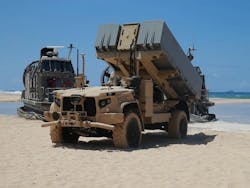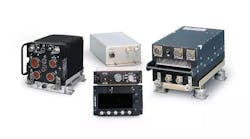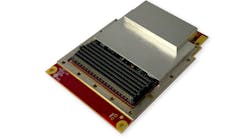QUANTICO MARINE BASE, Va. – U.S. Marine Corps expeditionary warfare experts are asking Raytheon Technologies Corp. (RTX) to start building a new Marine Corps land-based anti-ship missile system.
Officials of the Marine Corps Systems Command at Quantico Marine Base, Va., announced a $49.4 million contract Friday to the RTX Raytheon segment in Tucson, Ariz., to build low-rate initial production units of the Navy Marine Expeditionary Ship Interdiction System (NMESIS) launcher.
NMESIS will provide the Marine Corps High Mobility Artillery Rocket System (HIMARS) battalions with anti-ship missiles. NMESIS integrates a Naval Strike Missile (NSM) launcher unit, capable of launching two NSMs, onto a ROGUE-Fires carrier for shore defense.
The ROGUE-Fires long-range anti-ship missile launchers will be based on unmanned remotely operated versions of the Oshkosh Joint Light Tactical Vehicle (JLTV), each which will carry two Naval Strike Missiles (NSM) to help protect Marine Corps infantry on invasion beaches.
The NSM has an imaging infrared seeker, an onboard target database, and navigates by Global Positioning System (GPS), inertial sensors, and terrain-reference systems. It can detect, recognize, and discriminate among targets independently, and is designed to strike enemy ships at or near the water line to inflict maximum structural damage.
Raytheon is building the NSM in partnership with Kongsberg Gruppen in Kongsberg, Norway. In addition to NMESIS, the missile is to equip the littoral combat ship and FFG(X) future frigate with stand-off surface-to-surface weapons capability.
Raytheon and Kongsberg in their initial OTH-WS bid offered the Naval Strike Missile (NSM) -- a fifth-generation long-range, precision-strike missile that offers strike capability against heavily defended land and sea targets. NSM is a modernized version of the Norwegian Penguin anti-ship missile.
Experts from the Marine Corps and Raytheon tested the NMESIS off the coast of California in April 2021. The ROGUE Fires vehicle is remotely operated using the teleoperator or leader-follower modes. It was built for the Marines to support anti-ship operations from the ground.
The ROGUE Fires version of the JLTV lacks a crew cab and body, and is integrated with sensors and cameras, with a launcher mounted on top of the vehicle. Marine Corps leaders say they plan eventually to launch future weapons from ROGUE Fires.
On this contract Raytheon and Kongsberg will do the work in Kongsberg, Norway; Mooresville, N.C.; and Tucson, Ariz., and should be finished by January 2027. For more information contact RTX Raytheon online at www.rtx.com/raytheon, or Marine Corps Systems Command at www.marcorsyscom.marines.mil.



